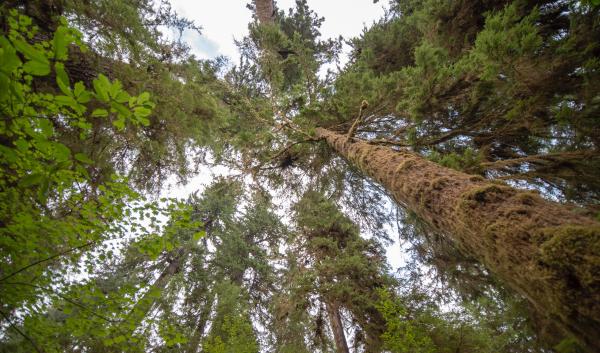How do forests respond to climate change? Or air pollution? Or whole tree harvests?
At the Hubbard Brook Experimental Forest (HBEF) in New Hampshire, scientists are finding out. Hubbard Brook is the USDA Forest Service site that first discovered acid rain in the U.S. Researchers there have been carrying out experiments across forest plots and even whole watersheds for over 65 years. Over the decades, scientists have thrown everything at this forest including cutting, acidifying, liming, freezing, icing, and droughting. However, these experiments are nothing compared to what nature has in store for the forest now and in the years to come. A progression of non-native insects is steadily making their way into the northeast. The response of trees at Hubbard Brook to these insects will serve as an example for forests across the region. These invaders are hopping rides on wood products or firewood moved into the region or making their own way north as the climate of the Northeast continues to warm.
Emerald Ash Borer
Just this past summer, John Deitsch, an undergraduate student researcher from Cornell, found a single adult emerald ash borer at Hubbard Brook. The emerald ash borer is a beetle native to northeastern Asia and was first found in this country in Michigan in 2002. The recent discovery at HBEF was soon confirmed by forest health specialists who noted the tell-tale “ash blonding” on many ash trees. The “blonding” - caused by woodpeckers that pluck off the outer dark layer of bark as they search for Emerald ash borer larvae – exposes the light-colored, inner bark. This is the farthest north the borer has been detected in New Hampshire and is a sign that the forest is in the early stage of infestation. Emerald ash borer beetles can kill ash trees within five years. With an estimated 26,000 ash trees in HBEF, the fate of these 100+ year old giants may be sealed - gone from the Hubbard Brook valley within the next decade. They will be swiftly replaced by other species such as American beech, sugar maple, and yellow birch. But the unique niche that ash trees offer to wildflowers, microflora, birds, and small mammals will be dramatically changed or lost altogether.
Hemlock Wooly Adelgid
Eastern hemlock also faces a troubled future at HBEF. Eastern hemlocks form dense stands in the lower elevations of the Hubbard Brook valley. They provide deep shade, cool temperatures, and food and shelter for wildlife. However, winter temperatures, particularly the coldest nighttime temperatures, are warming in the Northeast. As this happens the hemlock wooly adelgid continues to expand its range north. The wooly adelgid is an invasive, aphid-like insect native to Japan that was first found in Virginia in 1951. They feed by sucking sap from hemlock trees, which causes the needles to drop, the branches to die back, and eventually the trees themselves to die. The northward expansion of hemlock wooly adelgid is limited by minimum winter temperatures below ~-20 °F (-29 °C). At HBEF, as in most of the Northeast, winters are warming faster than the other seasons. Winter minimum temperatures at HBEF rose by 5oF between 1956 and 2016, and the number of cold nights below -20oF has declined by nearly 30%. As nights continue to warm and extreme cold snaps below -20oF become less frequent, it is likely that the wooly adelgid will find its way to the Hubbard Brook valley in the next decade. Yet another iconic species from the forest is likely to disappear. As with white ash, Eastern hemlock will be replaced by other species, likely white pine, and northern red oak. But the familiar deep shade and cool temperatures that hemlock stands provide to birds, mammals, fish - and people - will be changed.
HBEF scientists are ready to study how these insect invasions and the loss of white ash and Eastern hemlock will alter the nature of this forested valley.
The research will help communities across the Northeast respond to similar invasions still to play out. One concern is the southern pine beetle a native of the southeastern U.S. As the climate warms, it too is expanding its range northward attacking pines and other conifers. Another is the Asian longhorned beetle (ALB), a native to eastern China and Korea. It was first detected in New York in 1996 and attacks a wide array of forest tree species including maples, birches, elms, and willows. These and other invasive insects survive with less winterkill as the climate warms. Climate change can also stress host trees, making the trees more vulnerable to attack.
Long-term research is important to understand the dynamics of insect invasions and the response of host trees to these invasions.
How will the death and removal of some trees change the forest composition and function? And will there be domino effects on other plants and animals, big and small, that depend on these trees? We need this knowledge so that foresters and communities can better manage the forests of today and plan for the forests of the future.




